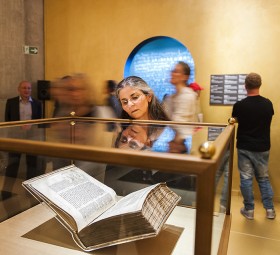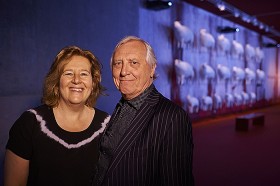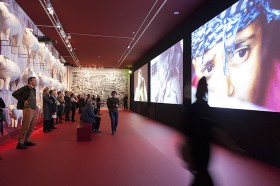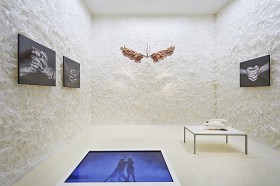A Conversation about the Exhibition “Obedience”
The exhibition “Obedience. An Installation in 15 Rooms by Saskia Boddeke & Peter Greenaway,” which has just been extended for two months, prompts extremely varied visitor responses. Atalya Laufer and Marc Wrasse regularly give guided tours of the exhibition. They talked to me recently about the experiences they’ve had, how they see the exhibition, and what they believe is at the root of visitors’ reactions.
Mirjam Wenzel: What form do your guided tours of the exhibition take?

Visitor in the “Golden Room” with manuscripts of the three monotheistic religions © Jewish Museum Berlin, photo: Jule Roehr
Marc Wrasse: We don’t so much guide visitors as accompany them on a three-step journey of discovery. We welcome the group and give a brief introductory talk, during which we point out that the Museum commissioned two artists to create the exhibition. Then, together with the visitors, we read aloud the relevant passage of the Bible—incidentally, the translation by Moses Mendelsohn—before leaving them to the exhibition.
Atalya Laufer: I prefer to use the translation by Martin Buber and Franz Rosenzweig.
Marc: But you too use roleplay, do you not, when reading the Bible story? That way, we make it clear that we want to explore the exhibition with our visitors and enjoy a shared experience. The second step in our journey is to briefly present some background information at two or three stations of the exhibition. Then, after the visit, we spend about 20 minutes discussing visitors’ impressions of the exhibition and how it made them feel.
Mirjam: What preparations did you make before embarking on guided group tours of this sort?
Atalya: We guides worked together as a group from the start, mainly on clarifying the main theme, since how the exhibition would look as a whole transpired only late in the day. The Museum’s educational department put a large number of texts at our disposal.
Marc: A reader, full of texts illuminating the traditional place of this story in Judaism, Christianity and Islam—as well as its significance in Israel today.

The curators Saskia Boddeke and Peter Greenaway in the exhibition © Jewish Museum Berlin, photo: Yves Sucksdorff
Atalya: … it also included feminist readings.
Marc: And then we got together one evening to watch Greenaway’s films. So we prepared ourselves for the task as a group, not only on our own. And, in conclusion, we had two discussions with the artists, who also gave us a guided tour of the exhibition.
Mirjam: Dear Atalya, you are an artist yourself—we already interviewed you for our blog. How do you feel about guiding others through an art exhibition?
Atalya: Of course, I end up asking myself: “How would I have resolved this or that?” It’s important in this exhibition also to clearly distinguish between the artistic work of Saskia Boddeke and that of Peter Greenaway—between their ways of manipulating other artworks, other artists’ work, by means of video-mappings, for instance—as well as between the original objects and the reproductions that are frequently paced directly alongside them, to all appearances, as objects of equal worth. This question of equivalence, of the relationship between an original and a reproduction is something that occupies me also in my own artistic work. Now, as a guide, I’m always asking myself what I should talk about with visitors—about a painting by Caravaggio, or Boddeke’s and Greenaway’s video-mappings?
Mirjam: You, dear Marc, are a philosopher—which is tied up with thinking, of course. Yet the primary intention of Saskia Boddeke and Peter Greenaway is not to make visitors think but to make them feel. How compatible is this with your approach to being in the world?
Marc: Well, I experience their approach as an opening and as an opportunity. Because knowledge, in our society, presents itself as sovereign knowledge and it makes sense, in my view, given this story and its impact, to undermine this claim to sovereignty. There is no surefire way to interpret this story, either in the religious tradition or for those of us hearing it now in a secular context. And it actually makes it all the more rewarding to see that a prestigious institution like the Jewish Museum Berlin doesn’t address the theme on the basis of established fact or in the form of a cultural historical exhibition but dares instead to present a dramatically staged exhibition that consciously seeks to prompt an emotional response.
Mirjam: But are all our visitors truly open to experiencing this staged event—even the avowedly secular among them who are dismissive of the Biblical narrative on several counts?
Marc: There’s evidently a big divide. Visitors with a Jewish, Christian or Muslim background, for whom this story is a quite matter-of-fact part of their cultural socialization, react very differently than those secular visitors who are not familiar with the Bible at all. In Berlin, we fortunately have a relatively large number of young Muslims who visit the Museum on school outings. In my experience, they take the exhibition very seriously and, during the subsequent discussion, they often try to explain to their schoolmates what the story means. And they then frequently fall back on the role played by the Abraham story in their own family tradition. That is lovely to see—not least because there are still plenty of young people for whom the story is a complete mystery and the context incomprehensible.
Atalya: And it’s likewise lovely to see that visitors who are very familiar with the Bible story nonetheless discover something new in the exhibition; to see that they are prepared to explore it, room by room, even though they already know the story inside out—and, most of all, to see them open up to the experience of things being not quite as they expected.
Mirjam: Were there any striking encounters with, or surprising responses from visitors that stayed with you afterwards?
Atalya: A guided tour I once did with children was very interesting. I wasn’t sure, initially, how I should present the exhibition to them but then I found myself in the white room titled “God and Angels” with them, and I asked: “How do you feel here?” There wasn’t much of a response so I said: “Imagine, everything here were red. How would that feel?” And that instantly triggered reactions. In the last large room with the video projections I first of all asked them to take a look at the wall with the knives. Among them is a potato peeler, for instance. And so I asked: “Which utensils do you know from the illustrations we have seen until now?” And with questions like that I did actually manage to distract their attention from the large video projections, which include images of children exposed to violence and war. “My children” perceived that room nonetheless, even without the videos, as an impressive exhibition space.
Marc: I was very moved by the sight of a Muslim father visiting the exhibition with his 12-year-old son and explaining the story to him. It was great to see the two of them come to the Jewish Museum to visit this exhibition.
Mirjam: Many thanks for the conversation!

